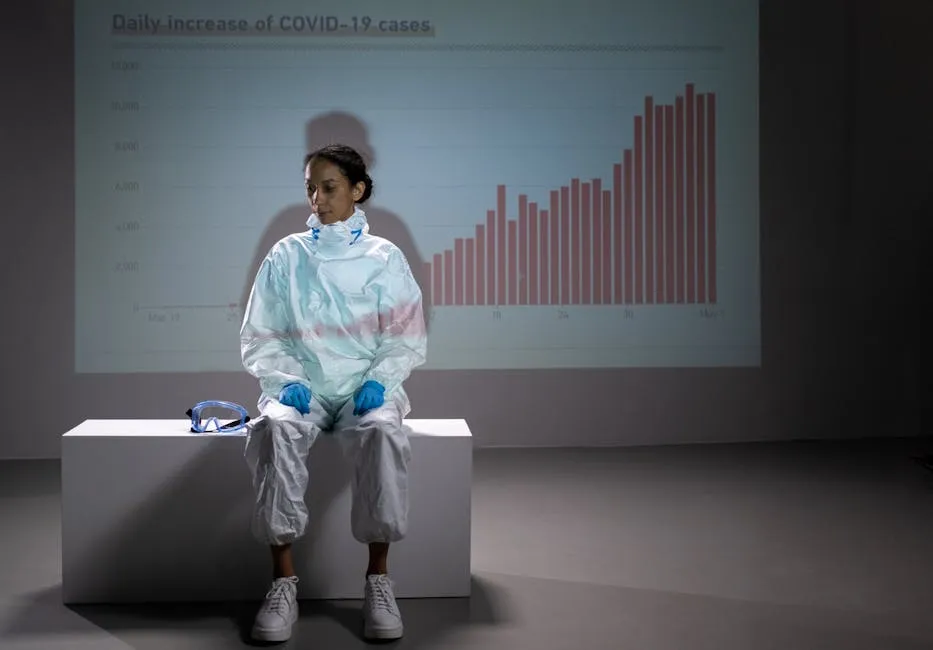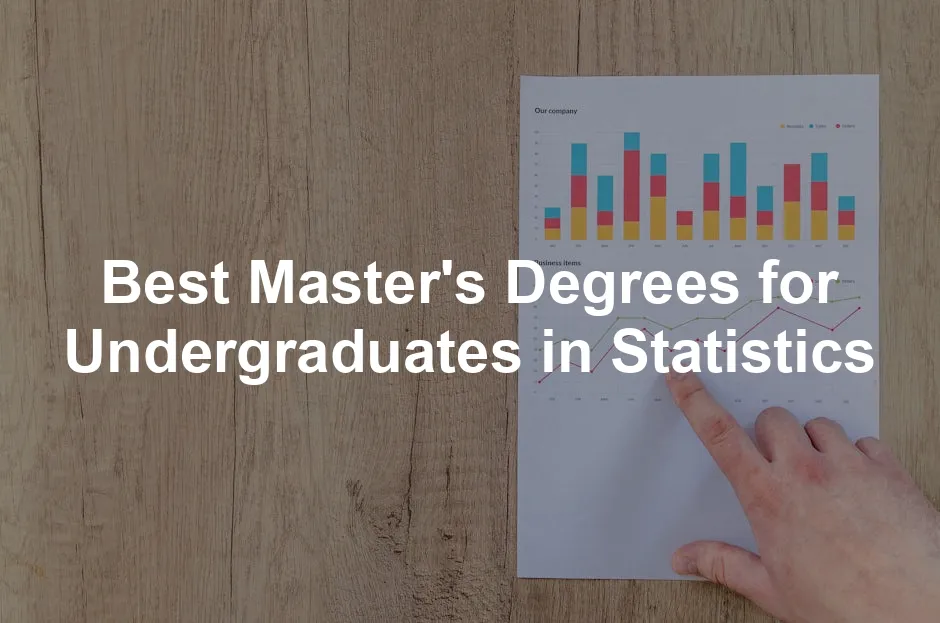Introduction
Advanced education in statistics is crucial. It’s not just about crunching numbers anymore. It’s about making sense of the overwhelming data surrounding us. As businesses and organizations become more data-driven, the demand for skilled statisticians and data analysts grows.
Industries like healthcare, finance, marketing, and technology are scouring for professionals who can interpret data trends. Statisticians are the superheroes of this data world, turning raw numbers into actionable insights. They help companies make informed decisions, predict future trends, and even save lives through research analysis.
This article explores the best master’s degrees available for undergraduates in statistics. We’ll focus on their relevance, curriculum, career prospects, and more. Whether you’re eyeing a career in data science, biostatistics, or market research, we’ve got you covered. So, grab your calculator and let’s dive into the exciting world of graduate statistics programs!

Understanding the Value of a Master’s in Statistics
What is a Master’s Degree in Statistics?
A master’s degree in statistics is a graduate program designed to deepen your understanding of statistical theories and methodologies. It equips students with advanced skills in data analysis, statistical modeling, and interpretation of complex data sets. With the world becoming increasingly data-centric, this degree is becoming essential. For those looking to dive deeper into the world of statistics, consider grabbing a copy of The Art of Statistics: Learning from Data by David Spiegelhalter. It’s a fantastic read that demystifies the world of statistics.
Statistical proficiency is not just a nice-to-have; it’s a must-have in today’s job market. As organizations rely more on data for decision-making, the importance of statisticians continues to rise. Graduates of these programs are well-prepared to tackle real-world challenges.
Advantages of Pursuing a Master’s in Statistics
Pursuing a master’s in statistics offers several advantages. First off, it opens doors to enhanced career opportunities. Graduates can step into roles like data scientists, statisticians, and market analysts. The earning potential is also significant. On average, professionals with a master’s degree earn substantially more than their bachelor’s counterparts. To get a head start on your data science skills, check out Statistics for Data Science by James D. Miller.
Additionally, this degree hones advanced analytical and technical skills. Students learn how to handle large data sets, apply statistical software, and conduct rigorous research. Specialization opportunities abound in fields like biostatistics, data science, and quality control. Whether you want to focus on healthcare, finance, or social sciences, there’s a niche for you.
In summary, a master’s in statistics not only boosts your career prospects but also equips you with the skills needed in a data-driven job market. The journey may be tough, but the rewards are worth it!

Types of Master’s Degrees in Statistics
Master of Science (MS) vs. Master of Arts (MA)
When it comes to master’s degrees in statistics, you’ll often encounter two main options: Master of Science (MS) and Master of Arts (MA). Both degrees offer unique advantages, yet they cater to different career paths.
The Master of Science (MS) is typically more technical. It emphasizes quantitative skills and scientific research. Expect heavy doses of calculus, linear algebra, and programming languages like R and Python. Graduates often find work in data analysis, actuarial science, and quantitative research. It’s all about the numbers, baby! If you’re looking for a great resource to learn Python for data analysis, try Python for Data Analysis by Wes McKinney.
On the other hand, the Master of Arts (MA) focuses on the theoretical aspects of statistics. This program often includes coursework in sociology, psychology, or education, making it ideal for those looking to enter fields like market research or social science. Think of the MA as the more “people-oriented” option.
Course requirements vary. An MS might require a thesis or capstone project, while an MA might not. Usually, the MS demands more science classes, whereas the MA leans towards humanities and social sciences. A degree’s direction often influences job prospects and potential roles.

Specialized Programs
Applied Statistics
Applied statistics focuses on real-world problems. This program teaches students how to use statistical methods to analyze and interpret data. Key courses often include regression analysis, experimental design, and survey sampling. It’s all about practical applications! For a deeper understanding of applied statistics, check out Practical Statistics for Data Scientists by Peter Bruce.
Career outcomes for graduates are promising. Applied statisticians can work in diverse sectors like marketing, finance, and healthcare. They might become data analysts, market researchers, or quality control specialists. The ability to apply statistical techniques in real-life scenarios makes them highly sought after. For more insights on this subject, check out the Master of Science in Applied Statistics for Social Science Research.

Biostatistics
Biostatistics is a specialized branch that plays a crucial role in healthcare and pharmaceuticals. This program focuses on applying statistical methods to biological and health-related fields. Students study topics like epidemiology, clinical trials, and survival analysis. If you’re curious about the statistical methods that can help in these areas, consider reading Data Science for Business by Foster Provost.
The importance of biostatistics cannot be overstated. It helps researchers make sense of complex medical data. Graduates can expect to find job opportunities in hospitals, pharmaceutical companies, and government agencies. Job prospects are bright as the demand for biostatisticians continues to grow with the expanding healthcare industry.

Data Science
Data science is where statistics meets computer science. This interdisciplinary program blends statistical methods with programming and domain expertise. Students learn data manipulation, machine learning, and data visualization. It’s a hot field, and the demand for skilled professionals is skyrocketing. For those interested in this area, a comprehensive guide on statistical inference for estimation in data science can be invaluable.
Exploring data science techniques is essential for modern statisticians. Learn more about data science and statistical inference here.

Online vs. On-Campus Programs
Choosing between online and on-campus programs can be overwhelming. Each format has its advantages and disadvantages.
Online programs offer flexibility and convenience. They allow students to balance work and study while accessing top-notch education from anywhere. This format is perfect for those juggling work or family commitments. However, the lack of face-to-face interaction can be a downside for some.
On-campus programs provide hands-on experiences and networking opportunities. Students can engage with professors and peers directly, fostering collaboration. However, they often require a significant time commitment, which may not be feasible for everyone.
Consider your personal circumstances when choosing a format. Do you thrive in structured environments, or do you prefer the freedom of online learning? Reflect on your learning style and future career goals to find the right fit. This decision can significantly impact your educational experience and career trajectory.

Top Master’s Programs in Statistics
Overview of Top Universities
Choosing the right master’s program in statistics is crucial for future career success. Various prestigious universities offer stellar statistics programs, each with unique features that cater to different student needs. Here’s a roundup of some top contenders, based on rankings from QS and THE.
1. Stanford University – MS in Statistics
Located in the heart of Silicon Valley, Stanford boasts a top-tier MS in Statistics. The program emphasizes both theoretical and applied statistics. Students gain access to cutting-edge research and notable faculty, including award-winning statisticians who bring real-world experience into the classroom. The program typically spans two years, with options for part-time study available.
2. University of California, Berkeley – MA in Statistics
Berkeley’s MA in Statistics is renowned for its rigorous curriculum and research opportunities. The program includes core courses in statistical theory, data analysis, and experimental design. With a vibrant campus atmosphere, students engage in various research projects, often collaborating with industry partners. The program usually lasts about two years.
3. North Carolina State University – Master of Statistics
NCSU offers a Master of Statistics that focuses on practical applications. The program is designed for students looking to enter the workforce immediately after graduation. NCSU has strong ties with the industry, providing students with valuable networking opportunities and internships. The program typically takes two years to complete.

4. Texas A&M University – MS in Statistics
Texas A&M’s MS in Statistics provides diverse concentration options, including biostatistics and data science. This flexibility allows students to tailor their education according to their career aspirations. The faculty is highly supportive, ensuring students have access to resources for research and career development. The program duration is about two years.
5. Columbia University – MA in Statistics
Columbia’s MA in Statistics emphasizes a strong theoretical foundation alongside practical data analysis techniques. The program is uniquely situated in New York City, providing students with excellent internship and job opportunities. Students benefit from small class sizes, fostering a close-knit learning environment. The program usually runs for two years.

Example Programs
– Stanford University: The MS in Statistics at Stanford is designed for those who want to excel in both theoretical and applied statistics. The program includes courses in statistical modeling, machine learning, and data analysis. Notable faculty like Professor David Dunson, known for his work in Bayesian statistics, enhance the learning experience.
– University of California, Berkeley: Berkeley’s MA in Statistics features a robust curriculum that incorporates statistical computing and experimental design. Students have access to research opportunities in various fields, including public health and environmental science. Faculty members, including Professor Bin Yu, are recognized leaders in statistical learning and data science.
– North Carolina State University: The Master of Statistics program at NCSU emphasizes practical applications of statistics in various industries. The curriculum is designed to prepare students for immediate employment, with a strong focus on data analysis and statistical consulting. Faculty members are actively involved in industry projects, offering insights and connections.
– Texas A&M University: Texas A&M’s MS in Statistics offers a flexible curriculum with options for specialization in areas like biostatistics and analytics. The program is well-respected for its comprehensive approach to statistics, combining rigorous coursework with real-world applications. Faculty expertise ranges from experimental design to machine learning.
– Columbia University: Columbia’s MA in Statistics focuses on theoretical foundations while equipping students with practical skills in data analysis. The program is enriched by its location in New York City, providing students with numerous networking opportunities and access to leading firms in finance and technology. Faculty members, such as Professor David Madigan, contribute to the program’s distinguished reputation.

In summary, these top master’s programs in statistics not only offer rigorous academic training but also provide essential networking opportunities and industry connections. Whether you prefer the innovative environment of Stanford or the practical focus of NCSU, each of these programs prepares students for successful careers in various sectors, from healthcare to finance.
Factors to Consider When Choosing a Program
Choosing the right master’s program in statistics can feel like picking a favorite child. It’s a big deal! Here are some key factors to keep in mind:
Accreditation and Reputation
First things first, check if the program is accredited. Accreditation ensures the institution meets certain educational standards. Institutions like the Higher Learning Commission (HLC) or the Southern Association of Colleges and Schools (SACS) are reputable bodies to look out for. A strong reputation often translates into better job placement rates, so don’t overlook this step!
Curriculum and Faculty Qualifications
Next up, take a good look at the curriculum. Does it focus on areas you’re interested in? Look for programs that offer specialized courses in areas like biostatistics, data science, or machine learning. Equally important are the faculty qualifications. Professors with industry experience can provide valuable insights. Plus, having access to knowledgeable mentors can make a huge difference in your educational experience.
Networking and Career Support Services
Finally, consider the networking opportunities and career support services offered by the institution. A program that connects you with industry professionals through internships, alumni networks, or guest lectures can greatly enhance your job prospects. Career services that assist with resume writing, interview preparation, and job placement can also be a game-changer. After all, it’s not just about what you know; it’s also about who you know!

Career Paths and Job Opportunities
Typical Careers for Statistics Graduates
Graduating with a master’s in statistics opens a treasure trove of career opportunities. Statisticians, data analysts, data scientists, and market research analysts are just a few roles that await you. Statisticians apply statistical methods to solve real-world problems and are key players in sectors like healthcare, finance, and marketing.
Data analysts focus on interpreting complex data sets to help organizations make informed decisions. They often work in tech, finance, and retail. Meanwhile, data scientists combine statistics with computer science to build predictive models and algorithms. This role is in high demand, especially in tech companies. If you’re interested in a foundational understanding of statistics, consider Naked Statistics: Stripping the Dread from the Data by Charles Wheelan.
Market research analysts gather and analyze data on consumers and competitors. They help businesses understand market trends and customer preferences, driving strategic decisions. Industries hiring these graduates include healthcare, finance, government, and technology. So, whether you’re more into crunching numbers or telling a story with data, there’s a path for you!

Salary Expectations
Now let’s talk numbers—specifically, salary numbers. Graduates with a master’s in statistics can expect a healthy paycheck. Here’s a peek at average salary ranges for various positions:
– Statistician: $89,000 per year.
– Data Analyst: $84,000 per year.
– Data Scientist: Over $120,000 per year.
– Market Research Analyst: Approximately $68,000 per year.
It’s essential to note that salary can vary based on factors like location, experience, and specialization. For instance, those specializing in data science or machine learning often enjoy higher salaries than their peers in more traditional roles. To enhance your skills in machine learning, consider reading Machine Learning Yearning by Andrew Ng.
In conclusion, pursuing a master’s degree in statistics not only enriches your knowledge but also propels you into lucrative career paths. With the right program, you can turn your passion for numbers into a flourishing career!

FAQs
What is the typical duration for a master’s degree in statistics?
Most master’s programs in statistics typically take about two years to complete for full-time students. Part-time options are available, extending the duration to three or more years, depending on the student’s pace and course load.
Is a master’s degree in statistics worth it?
Absolutely! A master’s in statistics can significantly enhance your career advancement and salary potential. Many employers prefer candidates with advanced degrees, especially in data-intensive fields. The return on investment is often favorable, with higher salaries for graduates compared to those with only a bachelor’s degree.
What are the admission requirements for a master’s program in statistics?
Common prerequisites include a bachelor’s degree in statistics, mathematics, or a related field. Most programs require official transcripts, letters of recommendation, a personal statement, and a resume. Some may also ask for GRE scores, although this requirement is becoming less common.
Can I pursue a master’s in statistics online?
Yes! Many reputable universities offer online master’s programs in statistics. These programs provide flexibility, allowing you to balance work and study. Online formats often include interactive components and access to resources comparable to on-campus programs.
What skills will I gain from a master’s in statistics?
Graduates of a master’s in statistics program will develop key competencies, including advanced statistical analysis, data management, and statistical software proficiency. You’ll also enhance your problem-solving abilities, critical thinking, and communication skills, all crucial for interpreting and presenting data effectively.
Please let us know what you think about our content by leaving a comment down below!
Thank you for reading till here 🙂
All images from Pexels




